Team-BHP
(
https://www.team-bhp.com/forum/)
Few pics of INS Vikramaditya and its carrier battle group along with few other pics are available in another thread on TBHP for those
interested.
Old ships , like old soldiers, never die.....Their names, their crests and their battle honours are carried forward to newer ships that then carry forward the name. The current INS Godavari is the second ship to bear this proud name. For the interest of those with an inclination for naval history and trivia....
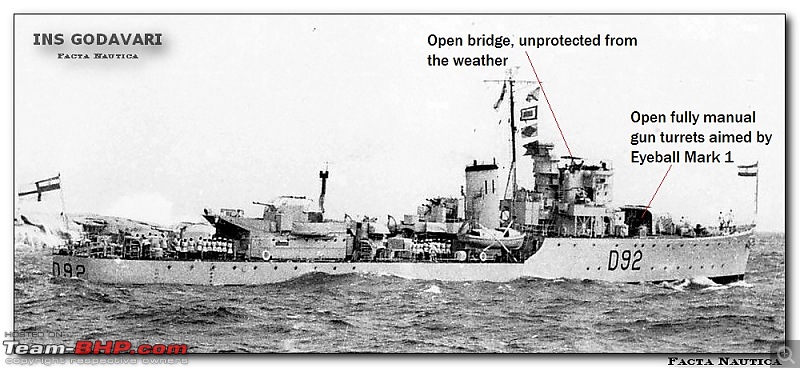
The first INS Godavari was a 2000 tonne world War II era escort ship. Today we would call her a corvette. Photo above of the first Godavari armed with three fully manual 4" guns and a few 40mm Bofors anti-aircraft self defence guns. The bridge from where the ship was controlled was fully open and you operated from there in sun, rain and hurricane.
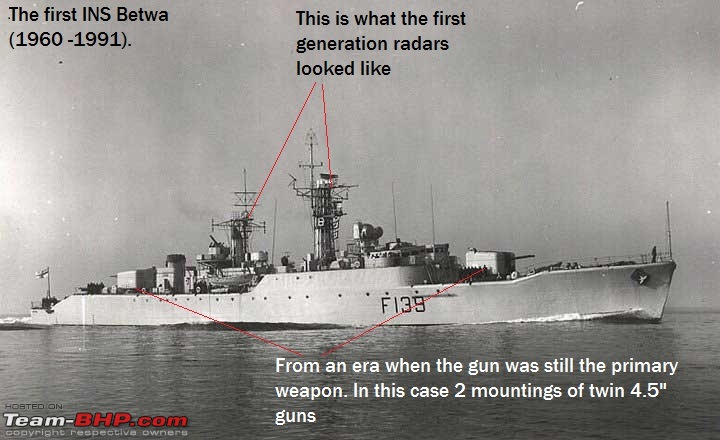
The modern trio of INS Brahmaputra, Betwa and Beas had predecessors that also were of one class. They were commissioned in 1958 to 1960 and were the first modern new warships to be inducted into the Navy after independence. Prior to that all additions to our fleet were second hand vessels from the Royal Navy. Photo of INS Betwa circa 1961. This trio escorted INS Vikrant in the 1971 operations and blockaded East Pakistan.
Quote:
Originally Posted by dhanushmenon
(Post 3658254)
DragonHawk, INS Vikramaditya was actualy not made to a dedicated aircraft carrier. It was a helicopter carrying cruiser. When India signed the deal to take it over, the ramp was built for our requirements removing the InterContinental Ballistic Missiles which were placed in that position.
|
I'm Being a little picky, but the missiles removed were certainly not ICBM's.
As far I know the only ocean going vessels who carry them are submarines.
The missiles removed were P-500 Bazalt supersonic cruise missiles (Surface to Surface, range about 500km) also known by NATO as SS-N-12 Sandbox.
More info here:
http://en.wikipedia.org/wiki/P-500_Bazalt Quote:
Originally Posted by DragonHawk
(Post 3658347)
Just to let you know how a battle group looks like, you can refer to the below image of US Navy battle group centered on USS Midway. Attachment 1347341
|
Although that is a carrier battle group, its more of what it appeared like about 30-40 years ago. The first ship from the left is a Iowa Class battleship, last of which was decommissioned 25+ years ago, probably was withdrawn from active service much earlier.
These larger escort ships have been replaced by smaller guided missile destroyers and cruisers.
I am not trying to be a killjoy here but I am not convinced of the RoI on building and operating multiple CBGs (Carrier Battle Groups). Sure they are a sight to behold and useful for conducting gunboat diplomacy ops, but in this age of long range accurate cruise missiles and sub-metre resolution satellites, and more ominously with carrier-killer missiles like DF 21D, carriers are becoming slow, hulking beasts extremely vulnerable to the right missile strike. To our navy's credit, they are aware of this. The Brahmos was originally designed by the Soviets to be a carrier killer.
But nuclear attack subs, they are a different animal. There is a reason why China desisted from developing carrier capability until very recently but went full steam ahead with building nuclear submarines - SSNs and SSBNs. India would do well with building a potent flotilla of SSBNs to prowl around the Indian Ocean and the South China Sea.
Quote:
Originally Posted by KL54
(Post 3665242)
I am not trying to be a killjoy here but I am not convinced of the RoI on building and operating multiple CBGs (Carrier Battle Groups). Sure they are a sight to behold and useful for conducting gunboat diplomacy ops, but in this age of long range accurate cruise missiles and sub-metre resolution satellites, and more ominously with carrier-killer missiles like DF 21D, carriers are becoming slow, hulking beasts extremely vulnerable to the right missile strike. To our navy's credit, they are aware of this. The Brahmos was originally designed by the Soviets to be a carrier killer.
But nuclear attack subs, they are a different animal. There is a reason why China desisted from developing carrier capability until very recently but went full steam ahead with building nuclear submarines - SSNs and SSBNs. India would do well with building a potent flotilla of SSBNs to prowl around the Indian Ocean and the South China Sea.
|
Dear KL54,
You raise an age old discussion that at least on paper we love to argue and theorize over. It is like asking which leg can you afford to have amputated - the right leg or the left one! Allow me to expound. Navies have many responsibilities in both peace and war - these include the ability to survey, track, warn and (hopefully never) to strike. A Navy should be able to do this across 4 dimensions - on the surface of the sea, below the surface of the sea, in the air and on amphibious terrain. Amongst the Armed Forces of a nation the Navy more than any other is most effective to raise the ante without a war. From the geopolitical equivalent of a stern raised eye brow to unlocking the safety catch on a revolver - a good Navy should be able to do all of it. There are many levels of conflict escalation short of actual warfare - a well equipped Navy is needed to be able to respond effectively (and hopefully douse) all these grey shades of escalation.
A submarine is a very potent weapon and could be devastating in actual war if used effectively and certainly is very very hard to detect (by surface ships). But a submarine has limited to no effectiveness in performing the hundred other duties a Navy has to perform in the 99% time we are at peace - from power projection, to disaster relief, to fighting piracy, to hopefully preventing terrorist from attacking from the sea (26/11), to providing air cover at seaÖ..I could go on. Similarly there are several tasks in actual war that a submarine cannot perform - air cover at sea, repeated shore attack, amphibious landings, escorting convoys, clearing minefields etc.
Just like a nation, for its automobile needs, has a requirement for large sedans, small hatchbacks, all wheel drives, LCVs, medium trucks, dumpers, buses, two wheelers, three wheelers and what not similarly in order to fill the hundred roles it has a Navy needs a
balanced mix of submarines, destroyers, minesweepers, aircraft carriers, missile boats, corvettes, supply depot ships, long range patrol aircraft, ship borne ASW helicopters and several others. Theorists who say down with aircraft carriers or who say SSBNs only are trying to figure out which of the four wheels of the car can you drive without.
As for SSBNs (ballistic missile nuclear submarines) they have a role as deterrents but only against an organized state adversary. They have little or no potency against the non-State trouble makers that abound on the globe today. So we need a little of everything - submarines, carriers, etc etc.
Photo below of INS Kalvari India's first submarine commissioned in December 1967. Foxtrot Class - 2500 tonnes submerged displacement, 20,000 kms range while snorkeling below the surface. 8 of this class formed the foundation of the Indian Navy's submarine arm.
Kind regards, Narayan
https://www.youtube.com/watch?v=AW76...980815782101A2
Video showing how the ski-jump works a topic that has been touched upon in earlier posts. In this case the aircraft is the Naval version of the Tejas LCA. The relevant screens are from the 55th second to about 1 minute and 25 seconds including a slow motion shot. Ski-jumps work best for aircraft which at take off have a power to weight ratio of 0.75:1.00 or better. Mig-29K, Sukhoi Su-30, Harrier are all in this category. - Narayan
Photos of the launch of INS Visakhapatnam on 20th April 2015. This is an improvement on the Kolkatta class which in turn are an improvement of the Delhi class. The ship is a testimony to our naval ship designers and to Mazagon Docks that they have persevered step by step despite the fact that our production schedules are not yet what they should be. With three variants introduced in about 2 decades this is a story line worth narrating. On the stocks the partially completed Visakhapatnam weighs about 3300 tonnes and when fully built and loaded she will displace 7300 tonnes. It was quite a sight to see this 163 metre behemoth sitting on cradles made of wood & steel slide into the water assisted by 5 tonnes of grease. I took a video (for the first time in my life) of the launch but can't figure out how to get it onto Youtube to link it here!
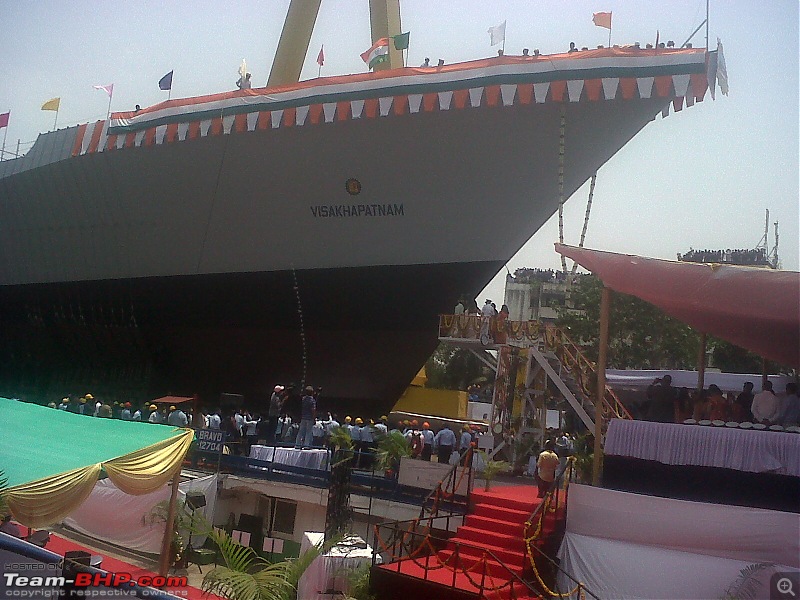
The launch ceremony being performed by Mrs Minu Dhawan the wife of the Naval chief. A ships launch is always done by a lady to harness the strength of Shakti, the might of Durga and the wisdom of Saraswati. Men may be essential for laying the keel but are superfluous for the launch:)
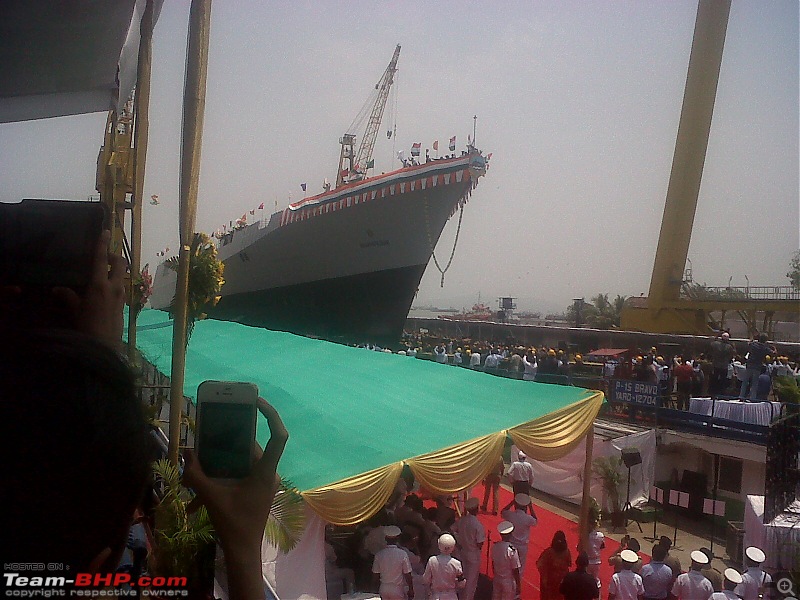
15 seconds later as she enters waters for the first time.
INS Viraat just loved the pic.
I have read somewhere that its extremely difficult to land the aircraft on this ship, as it requires lots of precision and timing to match the co-ordinates.
V.Narayan another great article.
Thankyou !
Quote:
Originally Posted by Rugged
(Post 3816004)
I have read somewhere that its extremely difficult to land the aircraft on this ship, as it requires lots of precision and timing to match the co-ordinates.
V.Narayan another great article.
|
Glad you enjoyed the reading. The thread below in the middle of the first post describes taking off and landing on a conventional carrier. INS Viraat will shortly be decommissioned.
http://www.team-bhp.com/forum/commer...dian-navy.html
INS Godavari, India's first indigenously designed guided missile frigate will sail over the horizon tomorrow. She decommissions on 23rd December 2015 after a full and eventful career of 32 years. During this period she served her country with honour in Operation Cactus (prevention of a coup against the Maldivian President), Sri Lanka operations, UN operations in Somalia and more recently extensive anti-piracy patrols off the coast of Somalia and the Gulf of Aden. She owes her masterful design to Captain Mohan Ram who figured how to expand the Leander design by 10% in all three dimensions without compromising structural integrity. It is an interesting and sad observation that INS Godavari commissioned the same year as the LCA Tejas project was conceived. Today more than a generation later INS Godavari retires while HAL and DRDO still try to get Tejas into full IAF service using tax payers money. Designing and building Godavari gave the Indian Navy and Mazagon Docks the confidence that we can go it alone and can integrate Russian & western weapon systems into a single vessel. Bear in mind this ship was designed in the 1974 to 1978 time frame when we could not design a car on our own.
Let's compliment the men who designed, built and sailed this proud ship. Jai Hind.
http://www.oneindia.com/india/warshi...3-1962787.html 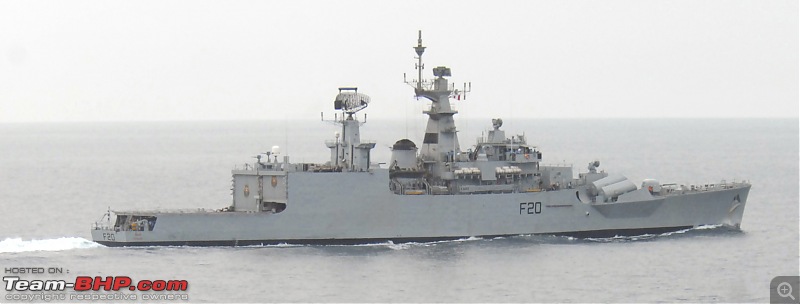
INS Godavari as she looks today with modernized radar, forward rapid fire Oto Melara 76mm gun and (I believe) the Barak anti-aircraft missile system
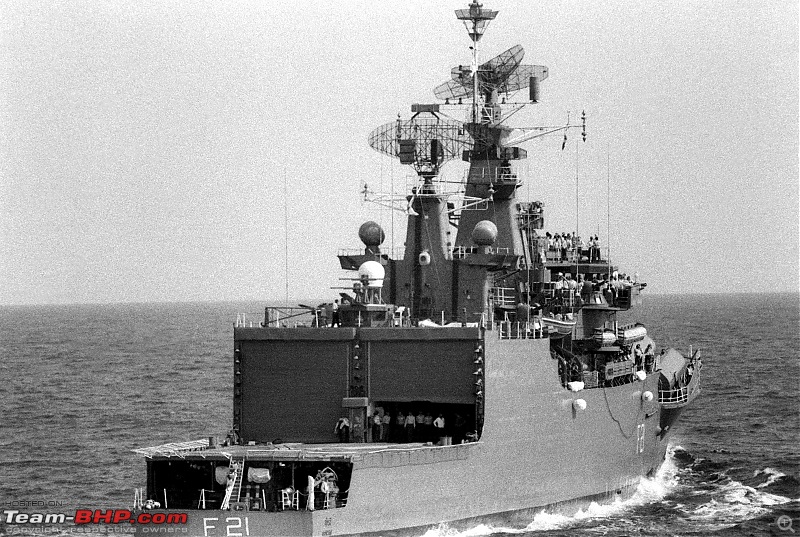
INS Godavari on her sea trials c.1983. Note the two hangars for the two Seaking ASW (Anti-Submarine Warfare) helicopters.
Quote:
Originally Posted by V.Narayan
(Post 3875957)
Today more than a generation later INS Godavari retires while HAL and DRDO still try to get Tejas into full IAF service using tax payers money.
|
Excellent point. Why, though? I don't know about DRDO, but IAF/HAL are conceptually the same as IN/Mazagaon Docks I would think. Although I suspect HAL hasn't done as badly as DRDO - who is more responsible for the Tejas fiasco? DRDO or HAL? Arjun MBT is of course almost entirely DRDO. But why could the IAF not do what the Navy could?
One question about the warships, having had some involvement in selling them propulsion engines. How reliant is the service on the supply of spares from abroad? Is it as vulnerable as the other two arms who leave themselves exposed to this when they procure combat platforms and systems from abroad?
Quote:
Originally Posted by Sawyer
(Post 3876124)
Excellent point. Why, though? I don't know about DRDO, but IAF/HAL are conceptually the same as IN/Mazagaon Docks I would think. Although I suspect HAL hasn't done as badly as DRDO - who is more responsible for the Tejas fiasco? DRDO or HAL? Arjun MBT is of course almost entirely DRDO. But why could the IAF not do what the Navy could?
One question about the warships, having had some involvement in selling them propulsion engines. How reliant is the service on the supply of spares from abroad? Is it as vulnerable as the other two arms who leave themselves exposed to this when they procure combat platforms and systems from abroad?
|
Thank you for a very pertinent question which involves us all as it is our tax rupees that funds Tejas and Arjun.
The Navy saw indigenization as a core philosophy of its own and not something thrust on them by the political leadership. It is an accepted lesson over the centuries that you can never buy yourself into being a powerful Navy instead you can only design and build yourself into one. So the Navy as long ago as 1950 started to train and develop their own Corps of Constructors ie Naval designers. This was foresight. Then in 1963 the decision to license build the Leander class frigates came from the Navy and was put forward to Pandit Nehru. It was not a political-bureaucracy decision imposed on the Navy a little unlike the HF-24 Marut (
http://www.team-bhp.com/forum/commer...t-fighter.html ). And finally in 1966 when the first Leander's construction was to commence the Navy didnít say to Mazagon Docks "I am your customer get cracking" instead it said I will depute my finest engineers to work under Mazagon Docks and we will jointly be responsible to get the first ship commissioned and will then work together to improve on it. The Navy also adopted a policy that if it is built in India then they (the Navy) will accept a standard product and then improve on it in steps rather than insist on the best on day one.
In the Navy, as opposed to the IAF (or any other Air Force for that matter) all branches go to war in the same vessel - the Executive branch who man the ships & weapons, the Electrical branch who maintain the ship at sea, the Engineering branch who drive the propulsion and so on. Naval men literally 'live' inside the machine ie the warship and run and repair it as a team.Therefore the understanding of the complexities of repair and by osmosis of production are better appreciated by the overall leadership. In the IAF the Flying branch which forms the leadership and are the ones who go to war are separate from the Maintenance branch who maintain the machines and hence there is a lesser appreciation in the IAF leadership of what it takes to design or build an aircraft.
With the Tejas, the IAF went overboard with its technical specifications back in the 1980s. They, in my humble opinion, simply asked for the latest this and the latest that with little co-relation to what capability existed in the country. There approach was XYZ is what I (the IAF) need to deliver on my responsibilities. It does not matter to me if they equipment comes from USSR's MiG factories or from HAL. This is my interpretation of the faulty birth of the Tejas saga having read about it as a civilian for over 3 decades. On DRDO I donít wish to comment. On Tejas my opinion is that the IAF should work with HAL on a full fledged trial squadron for a couple of years to iron out the snags and bring the machine to a reasonable standard of acceptability. To an extent that is what they are trying. All in all Tejas is a reasonable machine not brilliant but good enough. The only way to improve it is to put it into service and let the feedback come through. Perfection is the enemy of good enough on time.
On engine supplier reliability I do not have facts as I am a civilian enthusiast only. I suspect the vulnerability is similar to the Army or the IAF.
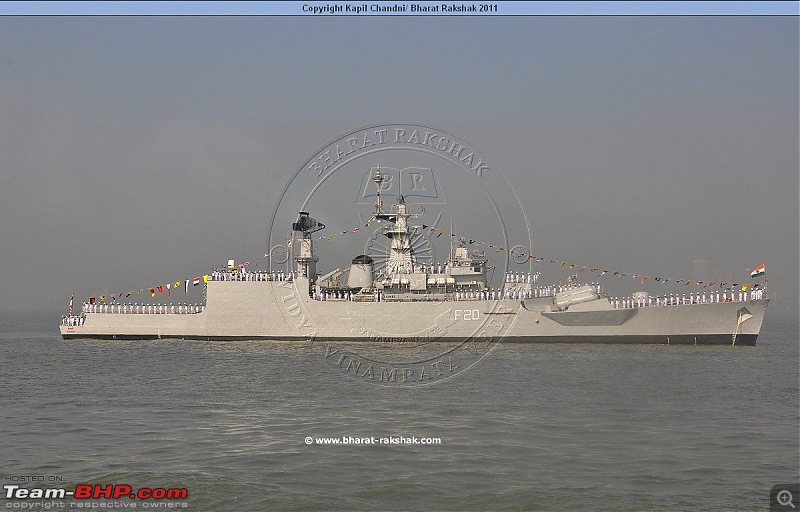 INS Godavari
INS Godavari: Designed 1974 to 1978; Built 1978 to 1983; Served 1983 to 2015
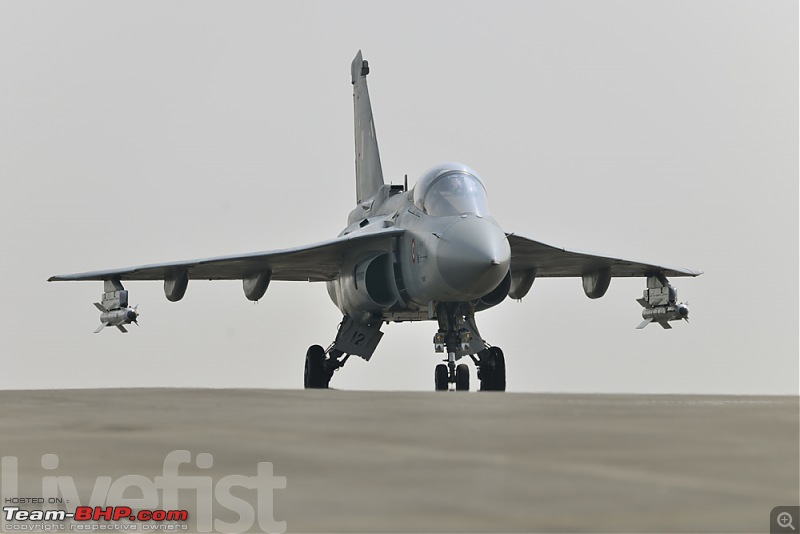 Tejas LCA
Tejas LCA: Conceptualized 1983 to 1985; First flew 2001; Current status - under trials & operational development. All in all a beautiful machine that deserves its own thread once the first squadron is formed.
Quote:
Originally Posted by V.Narayan
(Post 3878529)
On engine supplier reliability I do not have facts as I am a civilian enthusiast only. I suspect the vulnerability is similar to the Army or the IAF.
|
Hopefully, it isn't as bad as the other two. You can't have blue water aspirations with the spares supply chain subject to whims and fancies of other countries. It was a eye opener to read that the Navy was blessed with wiser leadership than the other two arms, leaders that thought strategically about equipment needs.
No one in India cares to understand that our armed forces aren't independent to the extent they need to be. I know that we cannot wage war for long because we haven't the money to do so, but that apart, our affinity to buy imported weapons systems instead of developing our own leaves us at the mercy of the same spares supplying countries that we love to import war fighting systems from. Shut off spares supplies, and the air force will be grounded in very little time. What's the use of the state of the art aircraft if they can't fly operational sorties for long?
Reading threads about the IN makes me feel very, very nostalgic for an age that is long gone.
I wonder what my late father would have thought had he seen such beautifully descriptive articles of the vessels and people of his era.
Thanks a lot V Narayan. I am so very grateful to you.
| All times are GMT +5.5. The time now is 19:14. | |









